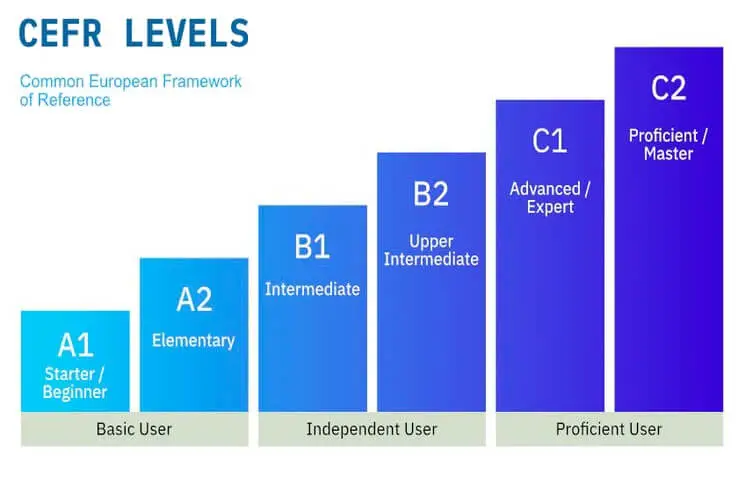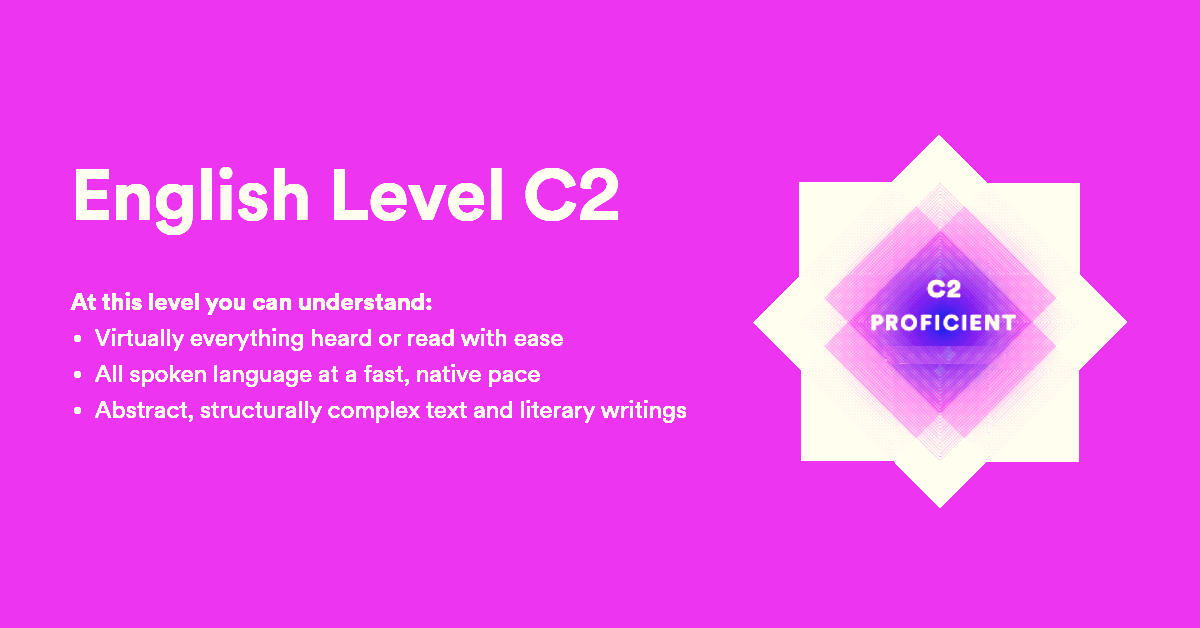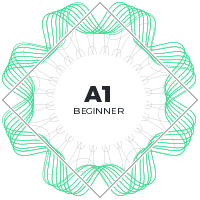C2 English Level (Proficient)
-
Comprehension of Complex Texts: Grasp intricate details in any text, including abstract or technical content.
-
Mastery of Spoken Language: Understand all spoken language, even at fast speeds or in unfamiliar accents.
-
Engagement with Sophisticated Texts: Handle texts with specialized vocabulary, showing independence and critical analysis.

C2 Proficient Level
The sixth and last level of English in the Common European Framework of Reference (CEFR), a list of various language proficiency levels created by the Council of Europe, is English level C2. This proficiency level could be described as “bilingual” in ordinary speech, as in “I speak both French and English fluently.” Technically, a native English speaker with a good education is at a C2 level. Because it is not necessary for their academic or professional aims, relatively few English learners achieve this level.


What is C2 Level?
Level C2 is part of the Proficient User Level, which is further divided into two sublevels: First and Second Proficient User Levels (C1 and C2). Although level C2 has been referred to as Mastery, it does not imply native or near-native proficiency. It is intended to characterize the degree of precision, appropriateness and ease of use in the language that typifies the speech of bright students. The descriptors graded here include: is able, by reasonably employing a wide range of modification mechanisms, to accurately convey subtle nuances of meaning; has a good command of idiomatic and colloquial expressions and is aware of the connotative level of meaning; knows how to circumvent difficulties so discreetly that the interlocutor hardly notices.
What are the C2 Level Skills?
Can easily understand virtually everything they hear or read
Can reconstruct information and arguments from various sources, whether in spoken or written language, and present them in a coherent and summarized manner
Can express themselves spontaneously, with great fluency and with a degree of precision that allows them to differentiate fine nuances in meaning, even in more complex situations
What will I be able to do after completing the C2 English Level?
Comprehension
Listening Comprehension
- Have no difficulty understanding any type of spoken language, whether in live conversation or in broadcast speech, even if it is produced at native speaker speed, as long as he has time to become familiar with the accent.
Reading Comprehension
- Read with ease virtually all forms of written language, including abstract, structurally or linguistically complex texts, e.g., manuals, specialized articles, and literary works
Speaking
Oral Interaction
- Effortlessly take part in any conversation or debate
- Be familiar with idioms, set phrases and colloquial expressions
- Express oneself fluently and accurately convey subtle nuances of meaning
- Get around difficulties so discreetly that others hardly notice
Oral Expression
- Present descriptions or arguments clearly and fluently, and in a style that is appropriate to the context, with a logical and effective structure that helps the listener to focus on the important ideas and remember them
Writing
Written Expression
- Write clear and fluent texts in a suitable style
- Write complex letters, reports or articles that present arguments in a logical and effective structure that helps the reader focus on and remember important ideas
- Write summaries and reviews of professional or literary works
Achieving CEFR Level C2
At the C2 level, learners demonstrate a mastery of the English language, allowing them to communicate with ease and precision across a wide range of complex and specialized topics. They can articulate arguments and express ideas with nuance, effectively engaging in both formal and informal discourse. Their ability to sustain complex discussions, analyze multiple perspectives, and express themselves fluently makes them comparable to native speakers in most respects.
C2 Listening
Learners at this level can understand virtually everything they hear, even when delivered at fast speed or in unfamiliar accents. They can follow intricate lines of argument in complex discussions, lectures, and presentations, including those involving abstract, specialized, or technical content. C2 learners are adept at discerning subtle nuances in tone, intent, and implication.
C2 Reading
At the C2 level, learners can effortlessly understand and analyze complex texts, including academic articles, literary works, and specialized reports. They can engage with material that includes abstract, technical, or specialized vocabulary, and are able to identify implicit meanings, rhetorical devices, and underlying themes. C2 learners can adapt their reading speed and style according to the purpose, using advanced strategies to interpret and critique the content.
C2 Speaking
C2 speakers can express themselves fluently, precisely, and spontaneously, even on complex or abstract topics. They can engage in extended discussions, debates, and presentations, articulating their thoughts clearly and effectively. Learners at this level can navigate intricate conversations, offering detailed explanations, constructing well-supported arguments, and responding appropriately to counterarguments. They are capable of adapting their language to suit the context, whether formal or informal, and can handle idiomatic expressions and colloquial language with ease.
C2 Writing
C2 learners can produce clear, well-structured, and sophisticated written texts on a wide range of topics. They can write with a high degree of accuracy and creativity, tailoring their language to fit different genres and audiences. Whether composing essays, reports, or literary analyses, C2 writers can present complex ideas, construct compelling arguments, and incorporate advanced rhetorical devices. They demonstrate an ability to express subtle nuances of meaning and maintain coherence and cohesion throughout their writing.
C2 Grammar
C2 grammar represents the highest level of grammatical proficiency according to the Common European Framework of Reference for Languages (CEFR). At this level, learners have a deep understanding and mastery of English grammar, enabling them to use the language with precision, flexibility, and sophistication across a wide range of contexts. Here’s what C2 grammar typically includes:
-
Complex Sentence Structures:
- Multiple Subordinate Clauses: Use of sentences with multiple layers of subordination, combining various types of clauses (e.g., relative, conditional, and adverbial clauses) in complex sentences.
- Embedded Clauses: Proficiency in using clauses embedded within other clauses for sophisticated expression.
-
Perfect and Continuous Tenses:
- Subtle Differences in Aspect: Mastery of nuanced differences between perfect, continuous, and perfect continuous tenses, such as conveying different aspects of time, duration, and relevance.
-
Modal Verbs:
- Advanced Modality: Use of modal verbs to express subtle shades of meaning, such as varying degrees of certainty, necessity, obligation, and possibility (e.g., “might have been,” “should have done”).
- Mixed Conditionals: Ability to create complex conditional sentences that mix time references and hypothetical scenarios.
- Passive Voice:
- Sophisticated Use of Passive: Flexible use of passive constructions across all tenses, including advanced forms such as causative passive (e.g., “have something done”).
-
Reported Speech:
- Complex Reported Speech: Mastery of reporting speech with multiple shifts in time, modality, and perspective, even in long and complex sentences.
-
Inversion and Emphasis:
- Inverted Structures for Emphasis: Advanced use of inversion for emphasis or stylistic effect (e.g., “Hardly had I arrived when…”).
- Cleft Sentences: Proficient use of cleft sentences to highlight specific elements (e.g., “What I need is a break”).
-
Subjunctive Mood:
- Advanced Subjunctive: Use of the subjunctive mood in formal or literary contexts, such as in expressing wishes, demands, or hypothetical situations (e.g., “If I were…,” “It is crucial that he be informed”).
- Ellipsis and Substitution:
-
- Ellipsis: Skillful use of ellipsis to avoid repetition and create cohesion in both spoken and written language.
- Substitution: Use of substitution to replace words or phrases for stylistic purposes and to create coherence.
-
Advanced Cohesion and Coherence:
- Linking Devices: Proficient use of a wide range of linking words and phrases to create complex and coherent discourse.
- Advanced Punctuation: Mastery of punctuation for clarity, emphasis, and stylistic effect, including the use of colons, semicolons, and dashes.
-
Idiomatic Language and Phrasal Verbs:
- Idiomatic Expressions: Use of idiomatic expressions, phrasal verbs, and collocations that are nuanced and context-specific, often incorporating them into sophisticated discourse.
- Phrasal Verbs: Command of phrasal verbs, including those with multiple meanings and those used idiomatically.
C2 Vocabulary
C2 vocabulary refers to the advanced and highly sophisticated range of words, phrases, idiomatic expressions, and collocations that learners at the highest level of English proficiency use. At this level, learners can express themselves with great precision, nuance, and fluency across a wide range of complex and abstract topics. Here’s what C2 vocabulary typically involves:
Advanced and Specialized Vocabulary:
-
Abstract and Technical Terms:
- Use of vocabulary related to abstract concepts, such as “epistemology,” “dialectics,” or “metacognition.”
- Mastery of specialized terms in fields like law, medicine, philosophy, technology, and other academic disciplines (e.g., “jurisprudence,” “cybersecurity,” “biotechnology”).
-
Nuanced Synonyms and Antonyms:
- Ability to choose from a wide range of synonyms and antonyms to convey subtle differences in meaning (e.g., “elucidate” vs. “clarify,” “obstinate” vs. “resolute”).
-
Precision in Word Choice:
- Proficiency in selecting the exact word or phrase to convey a specific idea or emotion, avoiding ambiguity or generalization (e.g., “reticent” vs. “shy,” “cautious” vs. “prudent”).
Idiomatic Expressions and Phrasal Verbs:
-
Complex Idioms:
- Use of advanced idiomatic expressions that are less common and often context-specific (e.g., “to throw down the gauntlet,” “a Pyrrhic victory,” “jump through hoops”).
-
Advanced Phrasal Verbs:
- Mastery of phrasal verbs, including those with multiple meanings or those used in idiomatic contexts (e.g., “to brush up on,” “to zero in on,” “to come across as”).
Collocations and Fixed Expressions:
- Complex Collocations:
- Use of advanced collocations, including those that are less predictable or more specialized (e.g., “make a concerted effort,” “provide an incisive critique,” “take a dim view of”).
- Fixed Expressions:
- Proficiency in using fixed expressions and set phrases that convey complex ideas succinctly (e.g., “by and large,” “to all intents and purposes,” “in the grand scheme of things”).
Figurative Language and Metaphors:
-
Sophisticated Metaphors and Similes:
- Ability to use and understand metaphors, similes, and other figures of speech that add depth and richness to communication (e.g., “a double-edged sword,” “as elusive as smoke,” “to navigate uncharted waters”).
-
Literary Devices:
- Use of literary devices such as irony, hyperbole, understatement, and euphemism in both writing and speech.
Advanced Adjectives and Adverbs:
-
Descriptive and Qualifying Adjectives:
- Mastery of adjectives that convey subtle distinctions in description or evaluation (e.g., “meticulous,” “superfluous,” “ineffable,” “intransigent”).
-
Adverbs of Degree, Manner, and Frequency:
- Use of sophisticated adverbs to modify verbs, adjectives, or other adverbs, enhancing the precision and subtlety of communication (e.g., “inextricably,” “invariably,” “tacitly”).
Formal and Informal Register:
- Register Flexibility:
- Ability to switch between formal and informal language effortlessly, adjusting word choice and expressions according to context (e.g., formal: “The results were unequivocally positive”; informal: “The results were a clear win”).
- Polite and Diplomatic Language:
- Mastery of polite expressions, hedging language, and euphemisms to navigate delicate or complex social situations (e.g., “with all due respect,” “it appears that,” “one might argue”).
Academic and Professional Jargon:
-
Field-Specific Vocabulary:
- Use of jargon and terminology specific to academic, scientific, or professional fields, demonstrating expertise and precision in those areas (e.g., “peer review,” “cost-benefit analysis,” “morphological analysis”).
-
Abstract Nouns:
- Proficiency in using abstract nouns that convey complex ideas and concepts (e.g., “serendipity,” “ethos,” “zeitgeist,” “hegemony”).
What can someone with an English C2 level do?
English at the C2 level is equivalent to native English. It enables diverse expression of feelings and thoughts, reading and writing of any kind on any topic, and active engagement in any academic or professional context.
A person with English language proficiency at the C2 level would:
- can easily understand almost everything heard or read.
- may reassemble arguments and accounts in a coherent presentation using information from various spoken and written sources.
- can speak clearly, effectively, and flexibly while distinguishing subtler shades of meaning even in the most difficult settings.
Details of C2 level English proficiency
For instructional purposes, the official can-do statements are divided into smaller sections. You can evaluate your own English proficiency using this more thorough skill breakdown, or a teacher can use it to evaluate a student’s proficiency.
A student at level C2 in English, for instance, will be able to perform all that a student at level C1 can do in addition to:
- talk about topics in science and technology, such as robots and recent inventions.
- discuss celebrities, celebrity action, and celebrity rumors.
- Use a range of strategies to encourage originality in your writing and speaking.
- Talk about financial planning, and provide clear guidance on personal finance.
- Discuss your own and your friends’ and coworkers’ stress levels.
- explore methods for conducting research on a variety of subjects.





